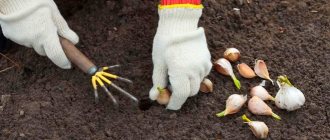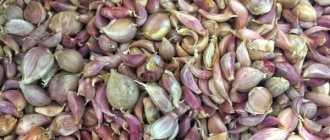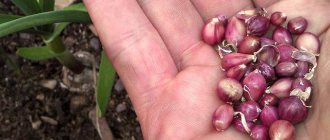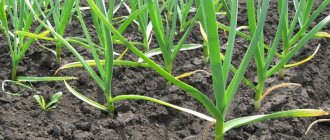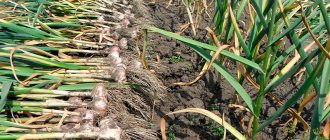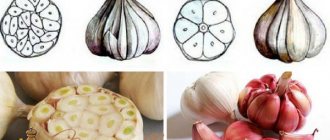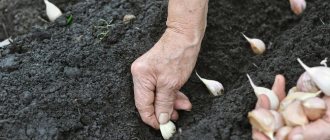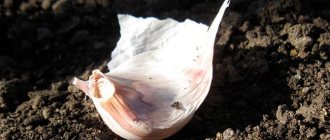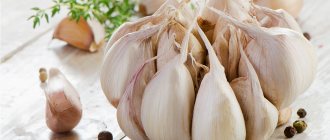297
Garlic is a famous vegetable crop, the cultivation of which is considered a good business. The positive thing is that this crop is easy to care for and resistant to adverse weather conditions.
Thanks to these qualities, garlic can be grown in any region of Russia, obtaining consistently good yields. But in order for the garlic yield to be “at its best”, it is necessary to follow the technology of growing the crop and then the business will be justified.
Advantages and disadvantages
Flaws:
- at the initial stage it is difficult to find a reliable supplier of seed;
- the need for soil cultivation and fertilization;
- To grow winter varieties of garlic, you will need soil containing sand;
- in the absence of wholesale buyers, sales difficulties may arise.
Advantages:
- high popularity of the product among the population;
- little competition;
- simple agricultural technology;
- possibility of growing in a small area;
- the presence of agricultural machinery is not necessary;
- small amount of start-up investment;
- To start this type of activity you do not need special knowledge.
Reference! When growing garlic, it is also advisable to grow vegetables and onions.
Benefits of Growing Garlic
Garlic is truly one of the most profitable crops to grow for sale: it has a high yield ratio and a decent price on the market. What are the competitive advantages of the bulbous plant?
- Garlic does not require the construction of greenhouses and greenhouses, which means it will be cheaper to grow than, for example, cucumbers or tomatoes.
- The cost of seeding material is quite affordable.
- Growing crops does not require specific skills or experience; even a beginner can handle the job.
- Garlic is always in demand, so you can sell it quickly and easily.
- Prices for garlic literally “take off” towards the end of winter and beginning of spring, therefore, by choosing a shelf-stable variety, you will hit a rather impressive “jackpot” during the season.
- Garlic is unpretentious and grows in any soil, but with proper care and feeding it will give maximum yield.
You can start a business even on 6 acres; a stable and high-quality harvest of the chosen crop will bring a guaranteed income.
If you want to sow a large plot of garlic or rent land from the state, then on such a large scale, even with the costs of workers and equipment, your business will pay off after the successful sale of the crop.
Material costs
To prepare the soil with an area of 20 acres you need to spend 6,000 rubles . According to the plan, this includes plowing, harrowing, and preparing the soil directly for planting. The price of planting material will be approximately 20,000, since at least 200 kg will be required for sowing on an area of 20 acres (at a price of 100 rubles per kilogram of seed material).
To prepare the soil you will need 8 tons of fertilizer - peat or humus. For this you will need to pay 25,000 rubles.
Storage of the grown product is possible:
- in an existing country house.
- construction of a specialized storage facility for garlic.
The total cost of creating a business according to the developed plan is about 90,000 rubles. But if you have a ready-made building adapted for storing garlic, the construction of a warehouse is no longer necessary. If there are good soil conditions that are suitable for growing bulbous crops, it is possible to reduce the amount of fertilizer applied. These factors can significantly reduce the amount of start-up production costs.
Profitability
Considering that the average yield per hectare is 13 tons of finished products, how much garlic can be obtained from 20 acres? In this case, from 20 acres you can expect about 2.5 tons of garlic, for an approximate amount of 25,000 rubles, with an average market price of 50 rubles per 1 kilogram.
Is it profitable to grow for sale on a large scale?
What benefits can you get from industrial outdoor cultivation? This business can rightfully be called promising and has high payback rates. This is due to the high demand for the product among the population. If you want to start a garlic business, then there is every reason to boldly start the business .
Reference! On average, profitability per 1 hectare for wholesale sales is 70%, for retail sales up to 150%.
Garlic yield per 1 ha in Russia
Garlic is a productive crop, which is why novice businessmen love to cultivate it. What kind of crop do farmers harvest from 1 acre? According to statistics, from 90 to 300-500 kg or from 9 to 50 tons of bulbs (heads) are collected from 1 hectare (ha).
Garlic has two varieties: winter and spring. They differ significantly in appearance, planting time, and care. Winter, compared to spring, usually produces a higher yield, which is associated with cold resistance and the ability to use moisture obtained as a result of snowmelt for growth.
Winter
Winter crops are planted before winter 15-20 days before the first persistent frost. It takes 8–9 months to develop. The bulb has a small number (4-10) of cloves adjacent to the stem (flower arrow). The average weight of the bulb is 50-60 g.
The bulbs are expelled by flower shoots, on which aerial bulbs (bulbs) are formed. If they are present, the mother bulb becomes smaller and the yield decreases. With large areas, it is difficult to remove the arrows from garlic, so the cost of the product increases.
is considered the most productive variety - 35 tons per hectare. 25 tons per 1 hectare can be obtained by growing the Messido variety, 15-20 - Spas, 18 - Petrovsky and 11.5 tons per 1 hectare - Polessky Souvenir.
Spring
Spring crops are planted in early spring (late March - early April), when the soil still contains a lot of moisture, but is already warmed up to plus 5-7°C. A spring garlic bulb fully ripens in 4-5 months. It has a large number of cloves (12-30). Head weight – about 15-30 g.
As a rule, spring garlic does not bolt, with the exception of the Gulliver variety. By following agrotechnical measures, high yields are achieved.
Spring garlic can be stored for a long time without loss of taste and beneficial properties - up to 2 years. Moreover, it can be stored at room temperature.
Of the spring varieties, the most productive variety is Aleysky. With proper cultivation, its yield reaches 14-16 tons of bulbs per hectare. The yield of varieties Sochi 56 and Strelets ranges from 7 to 12 tons per 1 hectare, Pluton - from 7 to 9, and Elenovsky - from 6 to 7 tons per 1 hectare.
Cultivation technology on an industrial scale
When wondering how to grow garlic on an industrial scale, a novice farmer must create a detailed business plan to successfully bring the business idea to life.
Market analysis
Garlic is in sufficient demand among people. When grown, both on an industrial scale and in a small agricultural enterprise, trade is possible in two forms:
- Retail . It is advisable to rent a small trading module, for example, at a local market.
- About . This will require establishing contacts with wholesale buyers.
The choice of the form of product sales primarily depends on its volume.
The payback period for this business is 1 season!
Total investment
In addition to the above monetary amounts (planting material, soil preparation and fertilization), it is necessary to take into account other costs associated with ensuring the activities of an agricultural enterprise :
- rent for the use of land;
- fare;
- wages to hired personnel if hired;
- costs of purchasing and using pesticides;
- fee for advertising services.
In each region of Russia, prices for the listed services are different and can vary greatly.
Choosing a tax system
When creating an agricultural organization, first of all, it is necessary to register it in the prescribed manner, in order to avoid violations of the current norms of the current legislation. Your business must be registered, especially when grown on an industrial scale.
When growing products in large industrial volumes, the best form of organizing activities would be an LLC. Limited liability company is a business company established by one or more legal entities and/or individuals, the authorized capital of which is divided into shares. The participants of the company are not liable for its obligations and bear the risk of losses associated with the activities of the company, within the value of their shares or shares in the authorized capital of the company.
For beginning entrepreneurs, the most convenient form of organizing production will be a peasant farm (peasant farm) - up to 1 hectare of land or as an individual entrepreneur (IP).
Types of taxation:
- peasant farms are subject to the unified agricultural tax (UST);
- individual entrepreneur – simplified taxation system (STS).
The tax rate is the same for both forms of registration. When registering, use the OKVED classifier code 01.13 “growing root crops, onion vegetables and tubers, such as carrots, beets, turnips, garlic, onions (including shallots), leeks and other onion vegetables.” Registration period is 1 month.
Algorithm of actions for registering an individual entrepreneur:
- Collection of a package of documents (application for state registration of an individual as an individual entrepreneur (form No. P21001); copy of passport; receipt of payment of state duty).
- State registration of an individual as an individual entrepreneur takes place at the tax authority at his place of residence, that is, at the place of registration indicated in the passport. If the passport does not contain the place of registration, then the registration of the entrepreneur can be carried out at the tax authority at the place of actual residence.
Submission of documents to the tax office. They can be submitted in person or remotely directly to the inspectorate.
- In person or through a representative by proxy. It is also possible to prepare documents at the multifunctional center - in person or through a representative by proxy.
- Reception of documents at the tax authority.
- Receipt by a person of documents on state registration.
- If all the documentation is in order, after 3 workers the USRIP entry sheet is issued to the applicant.
Documents can be obtained in person or through a representative using a notarized power of attorney.
Farmer reviews
Feedback from farmers about the prospects for growing garlic varies. There are some negative ones among them, but more positive ones.
Farmer with the nickname “Stranger V” (Kaliningrad, Russia): “I grew garlic for a couple of years, but gave up - it’s a difficult and thankless crop.”
Vitalka1988 (Volgograd region): “I decided to sell the bulk of the goods wholesale, in Volgograd. I sold garlic in various batches at a price of 90 to 100 rubles per kilogram... My wife also sold it at the market, sometimes in larger batches, and sometimes at retail. I rented it to a sausage shop or a bakery. Fellow villagers turned to me for goods, knowing that the product was of high quality and environmentally friendly... At the end of summer, people are just preparing for a long winter, making all kinds of canned food and twists that contain garlic, so the demand is high. Taking into account all the expenses, in the first year garlic brought me a considerable income - more than 17,000 rubles per month. And the next year, having increased the area and adjusted some details, I developed my business to an even larger scale in terms of earnings.”
Anna Guzovskaya (Krasnodar Territory): “In Russia, production does not compensate for all the needs of the domestic consumer. Therefore, most of it is imported from China. This type of garlic has many disadvantages, since the quality and shelf life are significantly inferior to our garlic. By renting 1 hectare of land, you can have 5-10 tons of harvest. And this is 1 million rubles. In addition, if you organize the rental of large areas of land, you must find contact persons in advance and conclude supply agreements with them. After this, you can safely start planting garlic!”
Sergey Alekseevich (Orenburg region): “Garlic is a good way to earn money, it doesn’t require large initial investments, you need to work with it 10-20 days a year (depending on what kind of garden you have), it pays off in the first year.”
Which variety should I choose?
The main varieties of garlic are:
- spring;
- winter.
Attention! The price of winter garlic seed material is higher than spring garlic, but the yield is also greater.
Winter garlic tolerates low temperatures well, has high yields, large bulbs and good taste. Its planting takes place from September to October. The most common and productive varieties :
- Scythian;
- Saved;
- Pluto;
- Doctor;
- Garkua;
- Autumn;
- Polessky;
- Ryazhsky;
- Lyubasha.
Spring varieties of garlic are suitable only for cultivation in the southern regions of the Russian Federation, since they do not tolerate low ambient temperatures. This increases the risk of crop failure from exposure to low temperatures.
The highest yielding varieties of spring garlic:
- Elenovsky;
- Kledor;
- Flavor.
Business plan
Before starting a garlic business, you need to draw up a competent business plan, which will indicate all the important details:
- First of all, it is necessary to describe the variety being grown, its taste, yield and other characteristics;
- The second important point will be the description of the acreage;
- The business plan must include a production plan, which will include a description of the planting process and technology for caring for plants;
- It is also necessary to indicate guaranteed distribution channels with which an agreement has already been concluded;
- The last and most important part of the business plan will be the calculation of expenses and estimated income.
Growing garlic for sale is a painstaking, but very interesting and profitable process. If you choose the right variety and get a beautiful and tasty harvest, the business can pay off and bring net income in the first year after planting.
Description of sown areas
The land for garlic crops must be drained and fertile. The degree of illumination of the area plays an important role. Garlic produces the highest yields when grown in a greenhouse, which also makes it possible to protect crops from exposure to adverse atmospheric conditions. Adding sand to the soil has a good effect, which increases its drainage.
Necessary equipment
With small volumes of sown areas, the presence of agricultural machinery is not necessary. But when growing on an industrial scale, mechanization of this process is mandatory. In this case, it is necessary to have or rent equipment :
- cultivator;
- tractor;
- conveyor;
- irrigation system;
- garlic harvesting machine.
The purchase of the above equipment will cost about 5,000,000 rubles. When running a business within a summer cottage, the above equipment will not be required, but you will still have to purchase gardening equipment worth about 20,000 rubles.
Where should you start a garlic business?
A business built on growing garlic begins with the selection of a suitable plot of land. Considering that this crop grows well in open ground, the construction of greenhouses will be unnecessary work that will only bring additional costs.
You can start a garlic business from a small summer cottage
In order to grow a rich harvest, it is enough to use a small summer cottage plot, several hundred square meters in size. At the first stage of business development, this area will be sufficient. When expanding the site, both the profit and the complexity of processing will increase, requiring additional costs, so you should first acquire regular customers who are ready to purchase the products and only then increase the acreage.
If a novice businessman does not own a plot of land, it can be rented. Its price will depend on the selected region, soil quality, etc.
Landing
It would be most advisable to plant winter varieties of garlic. It should be planted 40 days before the onset of the first frost. The best time is September-October.
Can be used for planting:
- aerial bulb (arrow bulb);
- sevok (one-toothed onion);
- one clove of the head.
It is recommended to change the seed every 3 years, which avoids the processes of degeneration of garlic varieties. It is better to use sets or one clove of garlic for planting, since the aerial bulb will yield a harvest only after 2 years. The volume of required seed depends on planting density and variety, but is in the range of 600-1,500 kg/ha.
We invite you to watch a video about planting large quantities of garlic:
The most productive varieties
Before you start planting, it is recommended that you familiarize yourself with the list of the most productive types of garlic. After all, the amount of harvest directly depends on the variety.
Lyubasha
The Lyubasha variety, which was bred in Ukraine, has proven itself well. If you comply with all planting requirements, you will be able to harvest approximately 35 tons of crop per hectare. The weight of the head in this case will be 80-120 grams. If the planting rules are not followed, the harvest will be average.
Ukrainian white
Another common and well-known variety is “Ukrainian White” (or purple). If all planting rules are strictly followed, you will be able to collect 15-20 tons per hectare. This variety is convenient to harvest, since the cloves are quite large and “vigorous”.
Care
Watering
From mid-April to early July, garlic is watered approximately once a week . During the rainy season, watering is reduced partially or even completely. When there is an abundance of rainfall, drainage grooves are created between the rows to prevent the accumulation of excess moisture in the soil. Which can lead to rotting of the bulbs.
In cold summers, garlic needs to be irrigated once every 9 days. Watering should be carried out in such a way that 5 to 10 liters of water are consumed per square meter of crops. During dry periods, the volume of water for irrigation can be increased to 12-15 liters.
Attention! It is recommended to stop watering garlic 3 weeks before the intended harvest.
Tillage
After heavy rains, a soil crust forms on the soil surface, interfering with the normal access of oxygen to the root system and deteriorating the growth conditions of the bulbs. After the end of the rains, it is necessary to carry out a process of shallow loosening (3-5cm). This improves soil aeration. Loosening must be done so as not to damage the bulbs.
Top dressing
It is recommended to fertilize garlic crops twice with nitrogen fertilizers at an interval of two weeks at the beginning of the growing season. Winter and spring garlic are fertilized half a month after the emergence of friendly shoots (April-May).
For feeding, a solution of slurry (1:10) and bird droppings (1:20) is also used . Phosphorus-potassium fertilizers are applied during planting of garlic. A good result is obtained by soaking the seed in solutions of humic fertilizers before planting; this increases germination by 20%.
Fertilizers should be applied to the soil only after watering or rain.
We invite you to watch a video about feeding garlic:
We wrote about the rules for caring for garlic in our material.
The ratio of the amount of planting material and harvested crop
The ratio of garlic yield to seed mass when propagated by cloves is approximately 1 to 4. Using bulbs is more economical. Since the reproduction rate increases by 10 times or more. Using bulbs for sowing, the ratio is already 1 to 50–85.
The consumption rate of seed material directly depends on the feeding area of one crop. Its size is determined by the main parameters:
- landing scheme;
- seed clove weight;
- soil fertility;
- characteristics of the variety.
For high-quality nutrition, one garlic crop is allocated from 2.5 to 5 square meters. cm of seating space for air seeds, from 8 to 10 sq. cm for cloves or single teeth. If the beds are wide enough, planting can be done in an economical checkerboard pattern. When sowing cloves, space 10 cm between holes and 5 cm between bulbs. On an industrial scale, automated seeders are used for planting. For wide-row sowings, 45 cm indentations are made between the rows with a bed width of 60 cm.
When planting bulbs, up to 50 kg of garlic per 1 ha will be required; when using cloves or single cloves, the seeding rate will depend on the size of the heads that are planned to be obtained, and ranges from 300 kg to 2 tons. Spring garlic is sown more densely (10 cm between bulbs, 16 cm between rows). Consequently, the consumption will be higher.
Diseases
The main diseases of garlic are:
- downy mildew of garlic;
- downy mildew;
- bacterial rot;
- neck rot of garlic;
- black moldy rot of garlic.
A wide range of agricultural products are available to combat garlic diseases. It is important to detect the source of the disease at the very beginning, which will save the harvest.
We invite you to watch a video about garlic diseases:
Why is it important to know yield?
For vegetable growing to be effective, it is necessary to make a good profit from the sale of grown products. The quantity of the harvest depends on:
- Planning sowing expenses for the purchase of seeds, their processing before planting, soil preparation, purchase of fertilizers for the soil.
- Degree of difficulty in caring for seedlings: labor intensity of the process, water consumption for watering, fertilizing, amount of loosening.
- Planning the timing and organization of garlic harvesting.
- Further storage of vegetables: selection of area for planting crops, cost of purchasing containers (boxes), transportation, processing.
Reference
The competitive advantages of growing garlic are very high. The crop is unpretentious, the cost of the seeds is reasonable, no specific skills are required for cultivation, the price of the harvested crop before winter is very high. Guaranteed profitability as a result of garlic cultivation is ensured even on 6 acres.
Possible problems and ways to solve them
The main problem in this type of activity is the lack of funding at the initial stage of activity. If there is sufficient financial investment, the garlic growing business does not bring any significant problems.
Growing garlic is a profitable and profitable activity. It can be started both on a personal plot and in large areas. You can also start growing garlic without experience in growing crops.
For anyone who wants to grow garlic on any scale, it will be useful to read about how to propagate it from seeds and how to process it before and after germination.
What influences high yields?
Getting a rich harvest from one hundred square meters or 1 hectare is influenced by a lot of factors that you should know before you start cultivating the crop:
- To begin with, it is important to consider the composition of the soil where the crop will be cultivated. The best yield can be expected in loamy soil with low or optimal acidity. Moreover, the more fertilizers based on organic matter and minerals are added to the soil, the higher the yields.
- Compliance with crop rotation is an important point that affects crop productivity. It is best to plant garlic after legumes, cabbage and melons (zucchini, eggplant, pumpkins), as well as after green manure. Throughout the growing season, such precursors fill the soil with useful macro- and microelements, which has a positive effect on the growth of garlic heads, which will be larger and healthier. A special table can help you choose the best predecessor, which indicates which vegetable grows better after which.
- Purchasing material for planting - first it is recommended to decide what type of garlic you will plant (winter or spring). In the first case, the bulbs will be strong and large (most often, the photo shows bulbs of winter varieties), and in the second, the harvest will be stored longer. Experienced gardeners advise purchasing productive local varieties that are zoned for a specific cultivation region.
Cloves or single cloves, which were obtained by growing garlic bulbs, are used as planting material.
- When cultivating a crop on a small plot of land, you can plant seed and harvest it yourself, manually, while harvesting a hectare will require equipment - a tractor with special equipment or a walk-behind tractor.
- The area where the crop will be cultivated should be in a sunny place.
- Garlic should not be planted in soil that is subject to the accumulation of melt water and precipitation. It is also desirable that the groundwater be deep from the planting site.
- The key to obtaining high yields is the removal of flower shoots longer than 10 cm, which is carried out at a certain time.
- Both spring and winter garlic are considered resistant to various pests. However, you should not neglect preventive treatment of planting material.
If you follow the recommendations for growing garlic, you will be able to get high yields from any piece of land, regardless of its size.
Factors affecting yield
The yield of such a vegetable is influenced by a large number of factors. In order to achieve good yields in garlic cultivation, you need to familiarize yourself with their list in advance.
Among the factors influencing the yield of the product in question, the following should be highlighted:
- variety (the most productive are considered: “Sofievsky”, “Alekseevsky”, “Gribovsky Jubilee”, “Lyubasha”, “Parus”, “Spas”);
- time and depth of planting;
- proper preparation of planting material;
- careful care (watering, fertilizing, protection from pests);
- soil and its chemical composition.
Find out how to store garlic in winter at home.
Sowing
Before sowing, it is necessary to disassemble the heads into individual cloves, calibrate them, choosing only the largest ones (large heads grow from them), and then disinfect them. You can use the herbicide "Totril", which not only improves the plant's immunity, but also prevents the growth of weeds.
Depending on the type of garlic and your climate, the sowing date will vary, but in general, winter varieties can be planted from early September.
In the selected area, mark furrows 20-25 centimeters deep, cover the bottom with a layer of clean river sand and ash. This will help the germinating garlic cloves not to rot during rains or melting snow. Place the seed at the bottom of the beds, keeping a distance of 10-12 cm between them. There should be about 20 cm of free space between the beds so that the root system, which is quite developed in garlic, does not intertwine with each other. Moisten the furrows before filling them with soil. After planting, be sure to mulch the beds with leaves, straw, pine needles or sawdust to prevent rapid evaporation of moisture.
Treatment and protection
Garlic contains many biologically active substances and is almost not susceptible to parasites and diseases. However, you can often observe how the leaves of this plant turn yellow and even curl into a tube. The main reason for this is dry soil, and the problem is often solved by simple watering.
Such procedures can be carried out only during the period of active growth and under no circumstances in the sun. For foliar feeding, it is better to use complex mineral fertilizers containing microelements.
How to plant garlic. Landing technique
Planting garlic is a complex and responsible process, on which the volume and quality of the harvest largely depends. A correctly planted clove should occupy a vertical position, its lower part must be pressed quite vigorously to the ground so that during digging it maintains a vertical position and begins to take root as soon as possible. The bottom of the clove should lie and be fixed on a sufficiently compacted bed; soil that is too loose should be rolled up before planting. Rolling with light rollers can also be recommended after planting, especially on soils with light mechanical composition. If rolling is not provided, then it is advisable to raise a small hump, which will protect against low temperatures and contribute to better overwintering of the garlic.
The above conditions can best be met by manually planting garlic in pre-cut furrows 8-12 cm deep according to the planting pattern. In order for the furrows to open better, metal plates are welded to the chisel-like legs of the hiller. Place cloves of garlic into the prepared furrows at a given distance and cover them with the same undergar with loops or a hoe.
We emphasize that such planting most fully meets the biological requirements of the crop. However, manual planting requires quite a significant investment of money and a lot of labor during the busy autumn period. You can significantly reduce the cost of manual labor (20-25 times) by using special garlic planters (for example JJ Broch) for planting garlic, the productivity of which is 2.5-3.0 hectares per seven-hour working day. However, machine planting of garlic has a number of disadvantages compared to manual planting. The main thing is that during machine planting it is not possible to ensure that the clove hits the bottom down.
Sales channels
Garlic is always in demand. It is used by pharmacists and cooks, housewives and chefs of expensive restaurants. But at the same time, the highest profits can be obtained in spring and winter. Although, wholesale companies purchase products in late summer - early autumn. During this period, the price of garlic is slightly lower, but the high yield is sold in batches.
The greatest revenue can be made if you go not to the reseller, but directly to the final buyer. Then a kilogram of the product can be sold for 100-150 rubles, but for this you need to organize a place in the market. If selling by yourself is not suitable for you, then you can easily find small resellers like vegetable stores who are willing to pay 50-60 rubles/kg, which is also quite good. When looking for good deals, you will have to go around several shops and talk to their owners, which often becomes a big obstacle to business development, since few people have experience in business negotiations.
The easiest option is to contact wholesalers, large resellers. In this case, a preliminary conclusion of a supply agreement will be required, which will ensure trouble-free sales of products in the future. The advantage of this method is that such companies take on all the risks associated with the further sale of goods. You can try to find other channels for selling the harvested crops, for example, offering cooperation to public catering establishments or local factories engaged in canning vegetables.
Growing garlic can be called a very successful business idea for aspiring businessmen in agriculture. This type of activity has good prospects for development. In addition, the cultivation of this product can be combined with other crops. Thus, a garlic business can be a good solution for both primary and additional business activities.
Mikhail
What is the yield of garlic from 1 hectare and 1 hundred square meters?
Before planting any garden crop, owners try to calculate future yields. Garlic is no exception. How many kg you get from 1 hectare depends on many factors.
Garlic yield standards
Gradually it occupies a niche as one of the profitable crops. It is actively grown in large quantities for sale. First of all, the yield of this crop depends on the variety. The most productive selection samples:
- Saved. A winter variety with a yield of up to 200 kg per 1 hectare (this is 20 t/ha). The head weighs up to 100 g. The variety has very high resistance to garlic diseases.
- . Productivity - 35 t/ha. The weight of one onion is 80-120 g.
- Purple Kharkov. Productivity - 11 t/ha. The heads are small - up to 60 g one. But the variety is immune to many diseases.
- Ukrainian white and purple. The indicator is about 15-20 t/ha. One onion weighs 60-140 g.
- Benefit. Productivity - 35-45 t/ha. In this case, the heads turn out to be large - 170-240 g. Garlic is resistant to some diseases and frosts.
Garlic yield depends on the variety
Of course, even the most productive variety will not produce the desired yield if other factors do not contribute to it:
- Chemical composition of the soil. Garlic loves loams with a neutral or low acidity level most of all.
- Soil fertility, high content of mineral and organic substances.
- Neighboring plants. Tomatoes, cucumbers, carrots, onions, peas and legumes will negatively affect the growth of garlic by taking nutrients from the soil.
- Predecessor plants. You should not plant garlic after the garlic itself, as well as onions and potatoes. Prepare the soil well:
- cucumbers;
- eggplant;
- zucchini;
- pumpkin;
- tomatoes;
- legumes;
- (except oats).
Ways to increase garlic yield
One of the key conditions for an abundant and healthy garlic harvest is proper agricultural technology. It is necessary to prepare the soil for the crop 1.5-2 months before planting, starting with the removal of all weeds. This can be done manually or using herbicides. Also loosen the soil regularly. In autumn, the soil should be fertilized with organic matter. 2-3 weeks before planting garlic, add minerals to it for deep digging, based on 1 hectare:
Planting material must be of high quality
- 100 kg nitrogen;
- 120-200 kg of potassium sulfate;
- and 100-120 kg of phosphorus.
Advice. The crop is susceptible to foliar feeding, especially during dry periods.
Planting material must be healthy and strong. Otherwise, you risk infecting the entire plantation with viruses or fungal infections. Continue to monitor weeds and loosen the soil after sowing. All work must be carried out carefully so as not to touch the shallow root.
Advice. Trim flower stems once they appear. According to gardeners, this technique will increase the yield by about 30%.
Watering is very important for garlic. The beds need to be irrigated regularly, especially in hot weather. At the turn of spring and summer, the plant requires water the most. But don’t overdo it: just water the area as the soil dries. Do this in the morning. Using simple recommendations, you will get stable and high yields of garlic.
How to get a big harvest of garlic: video
An alternative to making a profit is agriculture. Growing garlic as a business has become a profitable niche for gardeners and summer residents. This crop is in demand in summer and winter. The advantages of garlic are usefulness, piquancy and ease of care. The release of crops for sale is accompanied by many nuances; the main thing is to develop a clear action plan.

